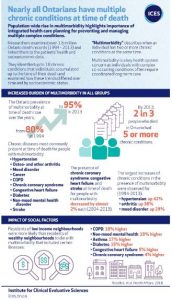Almost all Ontarians accumulate multiple chronic conditions over their lifetime
March 5/2018
By: Deborah Creatura, ICES Communications
The number of Ontarians who died with two or more chronic conditions increased from 79.6 per cent in 1994 to 95.3 per cent in 2013, according to a new study from Dalla Lana School of Public Health and Institute for Clinical Evaluative Sciences (ICES).
The study published today in the journal Health Affairs, examined more than 1.6 million deaths that were registered in Ontario from 1994 to 2013, and linked each to health administrative data from Ontario’s single payer health care system.

Laura Rosella discusses the health equity implications of her study at Health Affairs’ press conference in Washington, D.C. on March 6.
“By looking back in the linked data we identified 18 chronic conditions that individuals accumulated up to the time of their death and examined how these trends differed over time and by socioeconomic status,” says Laura Rosella, Assistant Professor of Epidemiology at the Dalla Lana School of Public Health.
The 18 chronic conditions the researchers identified were acute myocardial infarction, asthma, cancer, cardiac arrhythmia, chronic coronary syndrome, chronic obstructive pulmonary disorder, congestive heart failure, Crohn’s disease or colitis, dementia, diabetes, hypertension, mood disorder, osteo- and other arthritis, osteoporosis, other mental health disorder, renal failure, rheumatoid arthritis and stroke.
The study showed that almost all Ontarians accumulate multiple chronic conditions over their lifetime. The total number of chronic conditions that Ontarians died with increased over time. In 1994, about one quarter (24.6 per cent) of Ontarians died with five or more chronic conditions, this increased to two thirds of all Ontario deaths (65.7 per cent) in 2013.
The researchers found that the types of chronic conditions that Ontarians accumulated varied by socioeconomic groups. Individuals that lived in materially deprived neighbourhoods were more likely to die with chronic obstructive pulmonary disease (COPD), mental health disorders and diabetes. While cancer and dementia at time of death were more common among individuals that lived in high income neighbourhoods.
“The observed trends underscore the importance of integrated health care planning and delivery that can meet the health care needs of Ontarians with multiple and complex chronic conditions, as well as the need for chronic disease prevention and socioeconomic interventions that can address the inequities in the types of conditions Ontarians accumulate,” added Rosella, who is also adjunct scientist and site director at ICES U of T.
But there were some health gains across the board including the decline in the presence of chronic coronary syndrome, congestive heart failure and stroke at time of death, which decreased by almost two per cent each from 2004 to 2013.

Laura Rosella discusses the health equity implications of her study at Health Affairs’ press conference in Washington, D.C. on March 6.
Watch Professor Rosella participate in a live webcast panel discussion on March 6 at 11:00 a.m. EST. For live tweeting follow: @Health_Affairs and #healthequity
